Situated at the top of Carlton Street, this site has been occupied for centuries. Mr Gregory’s house was built here in 1674, on the site of an even older mansion. In 1810, Ichabod Wright moved his bank into part of Mr Gregory’s mansion, where a new banking house was built in c1860. Wright’s Bank was absorbed by the Capital and Counties Bank, later taken over by Lloyds. The bank closed in 1995 and became the Lloyds No.1 bar.
Prints, illustration and text about Joseph Southall.
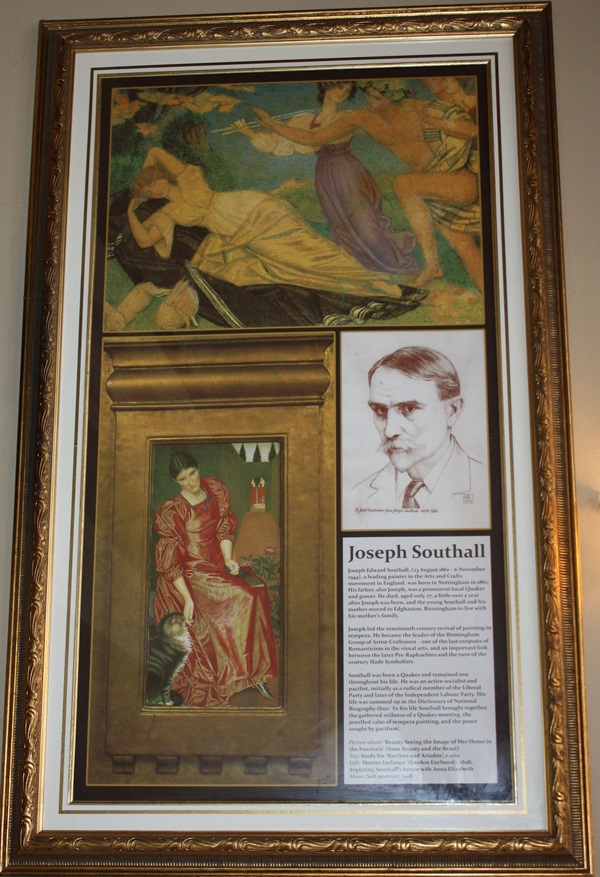
The text reads: Joseph Edward Southall, (23 August 1861- 6 November 1944), a leading painter in the Arts and Crafts movement in England, was born in Nottingham in 1861. His father, also Joseph, was a prominent local Quaker and grocer. He died, aged only 27, a little over a year after Joseph was born, and the young Southall and his mother moved to Edgbaston, Birmingham to live with his mother's family.
Joseph led the nineteenth century revival of painting in tempera. He became the leader of the Birmingham Group of Artist-Craftsmen - one of the last outposts of Romanticism in the visual arts, and an important link between the later Pre-Raphaelites and turn of the century Slade Symbolists.
Southall was born a Quaker and remained one throughout his life. He was an active socialist and pacifist, initially as a radical member of the Liberal Party and later of the Independent Labour Party. His life was summed up in the Dictionary of National Biography thus: 'In his life Southall brought together the gathered stillness of a Quaker meeting, the jewelled calm of tempera painting, and the peace sought by pacifism.
Picture above: ‘Beauty Seeing the lmage of Her Home in
the Fountain' (from Beauty and the Beast)
Top: Study for ‘Bacchus and Ariadne’, c.1912
Left: ‘Hortus Inclusus' (Garden Enclosed), 1898,
depicting Southall’s future wife Anna Elizabeth
Above: Self-portrait, 1918.
A print and text about Lord Byron.
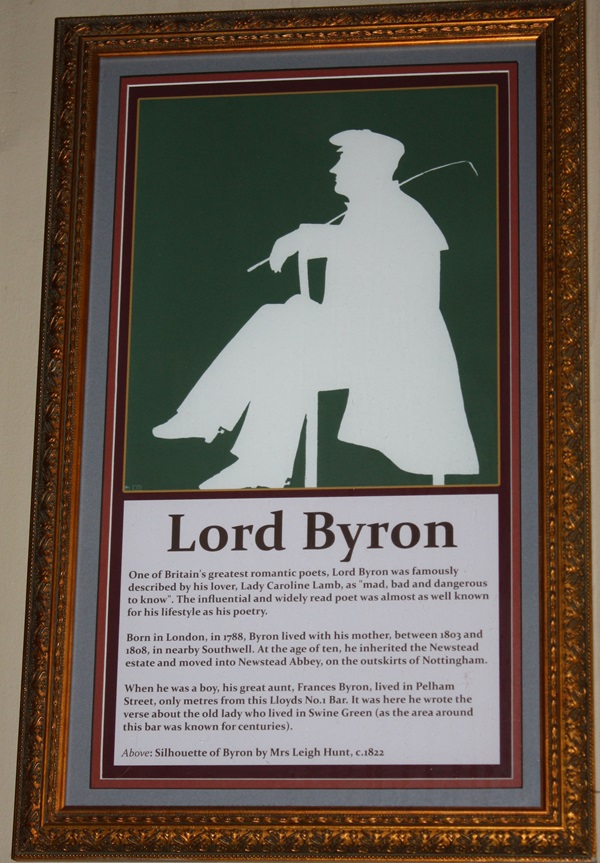
The text reads: One of Britain's romantic poets, Lord Byron was famously described by his lover, Lady Caroline Lamb, as “mad, bad and dangerous to know". The influential and widely read poet was almost as well known for his lifestyle as his poetry.
Born in London, in 1788, Byron lived with his mother, between 1803 and 1808, in nearby Southwell. At the age of ten, he inherited the Newstead estate and moved into Newstead Abbey, on the outskirts of Nottingham.
When he was a boy, his great aunt, Frances Byron, lived in Pelham Street, only metres from this Lloyds No.1 Bar. It was here he wrote the verse about the old lady who lived in Swine Green (as the area around this bar was known for centuries).
Above: Silhouette of Byron by Mrs Leigh Hunt, c.1822.
Prints of the Byron family.
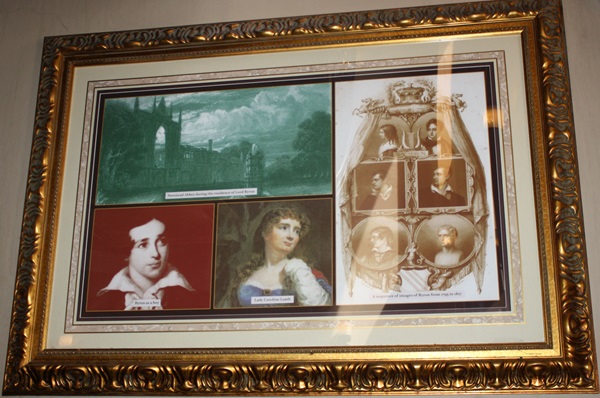
Top left: Newstead Abbey during the residence of Lord Byron
Bottom left: Byron as a boy
Middle: Lady Caroline Lamb
Right: A sequence of images of Byron from 1795 to 1817.
Photographs and text about Watson Fothergill.
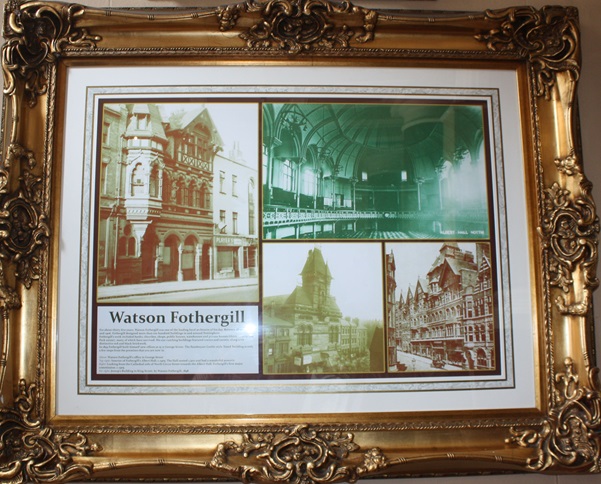
The text reads: For about thirty-five years, Watson Fothergill was one of the leading local architects of his day. In around 1906, Fothergill designed more than 100 hundred building in and around Nottingham.
Fothergill’s work included banks, churches, shops, public houses, warehouses and private houses (thirty or so are in the Park estate), many of which have survived. His eye-catching buildings featured towers and turrets, along with distinctive red and black brickwork.
In 1893 Fothergill built himself new offices at 15-17 George Street. The flamboyant Gothic style listed building is only a few steps from the premises that you are now in.
Above: Watson Fothergill’s office in George street
Top right: Interior of Fothergill’s Albert Hall c.1905. The Hall seated 2,599 and had a wonderful acoustic
Right: Looking from the Cathedral side of North Circus Street towards the Albert Hall, Fothergill’s first major commission, c.1905
Far right: Jessop’s Building in King Street by Watson Fothergill, 1898.
A photograph of Watson Fothergill, c.1885.
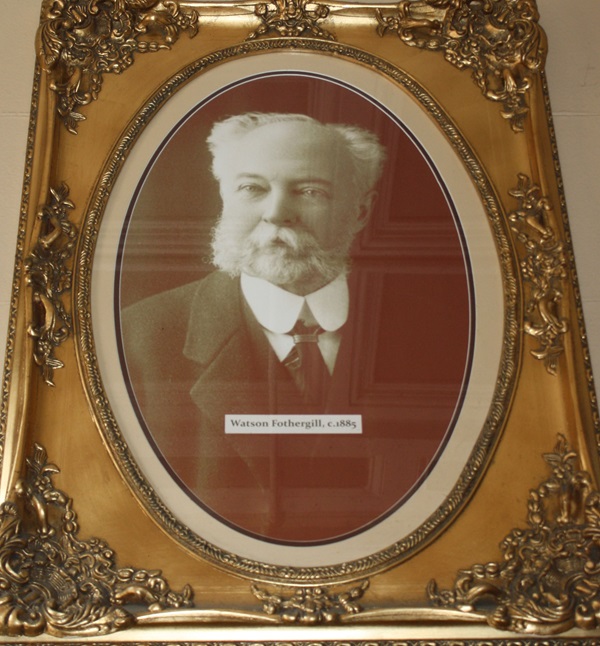
Photographs and text about 1 Carlton Street.
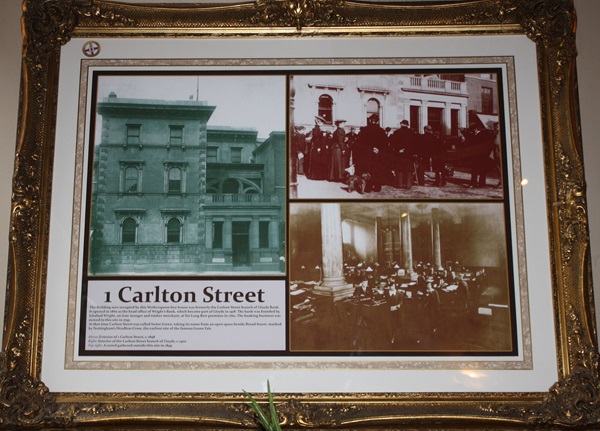
The text reads: The building now occupied by this Lloyds No 1 bar was formerly the Carlton Street branch of Lloyds Bank. It opened in 1860 as the head office of Wright's Bank, which became part of Lloyds in 1918. The bank was founded by Ichabod Wright, an iron-monger and timber-merchant, at his Long Row premises in 1760. The banking business was moved to this site in Carlton Street, in 1795
At that time Carlton Street was called Swine Green, taking its name from an open space beside Broad Street, marked by Nottingham's Headless Cross, was the earliest site of the famous Goose Fair.
Above: Exterior of 1 Carlton Street, c.1898
Right: Interior of the Carlton Street branch of Lloyds, c.1920
Top right: A crowd gathered outside this site in 1899.
A photograph of 1 Carlton Street, c.1900.
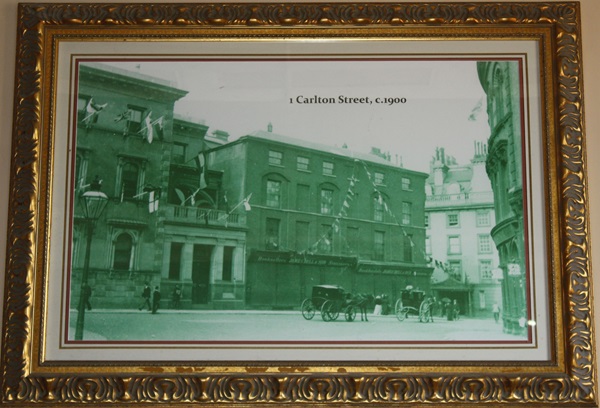
Illustrations, photograph and text about Dudley Dexter Watkins.
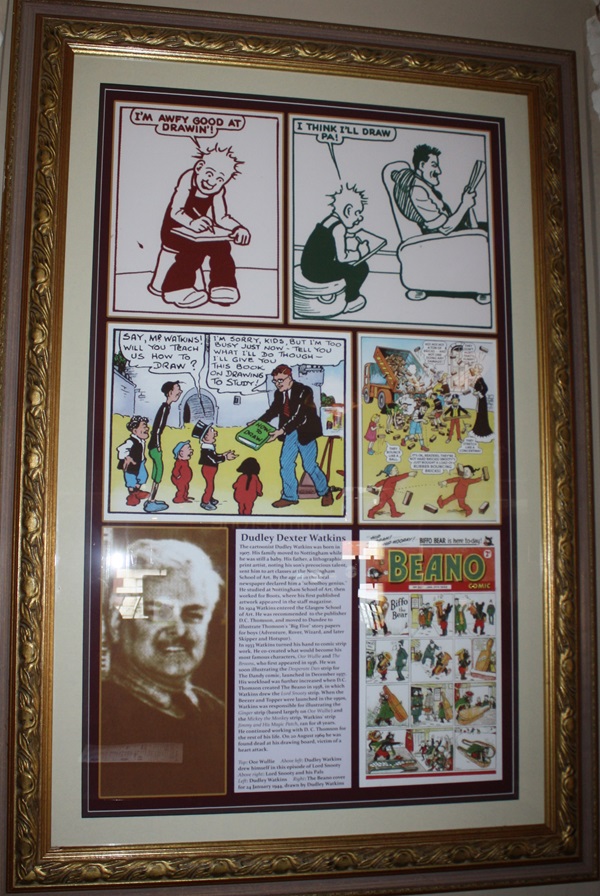
The text reads: The cartoonist Dudley Watkins was born in 1907. His family moved to Nottingham while he was still a baby. His father, a lithographic print artist, noting his son’s precocious talent, sent him to art classes at the Nottingham School of Art. By the age of 10 the local newspaper declared him a ‘school boy genius’. He studied at Nottingham School of Art, then worked for Boots, where his first published artwork appeared in the staff magazine.
In 1924 Watkins entered the Glasgow School of Art. He was recommended to the publisher D.C Thomson, and moved to Dundee to illustrate Thomson’s “Big Five” story papers for boys (Adventure, Rover, Wizard and later Skipper and Hotspur).
In 1933 Watkins turned his hand to comic strip work. He co-created what would become his most famous characters, Oor Wullies and The Broons, who first appeared in 1936. He was soon illustrating the Desperate Dan strip for the Dandy comic, launched in December 1937. His workload was further increased when D.C Thomson created the Beano in 1938, in which Watkins drew the Lord Snooty strip. When the Beezer and Topper were launched in the 1950s, Watkins was responsible for illustrating the Ginger strip (based largely on Oor Wullie) and the Mickey the Monkey strip. Watkins’ strip Jimmy and His Magic Patch ran for 18 years. He continued working with D.C. Thomson for the rest of his life. On 20 August 1969 he was found dead at his drawing board, victim of a heart attack.
A photograph and text about The Goose Fair.
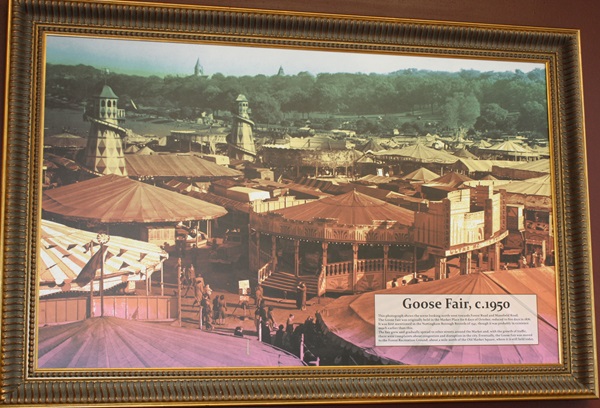
The text reads: This photograph shows the scene looking north-west towards Forest Road and Mansfield Road.
The Goose Fair was originally held in the Market Place for 8 days of October, reduced to five days in 1876.
It was first mentioned in the Nottingham Borough Records of 1541, though it was probably in existence much earlier than this.
The fair grew and gradually spread to other streets around the Market and, with the growth of traffic, there were complaints about congestion and disruption in the city. Eventually, the Goose Fair was moved to the Forest Recreation Ground, about a mile north of the Old Market Square, where it is still held today.
Prints and text about banknotes.
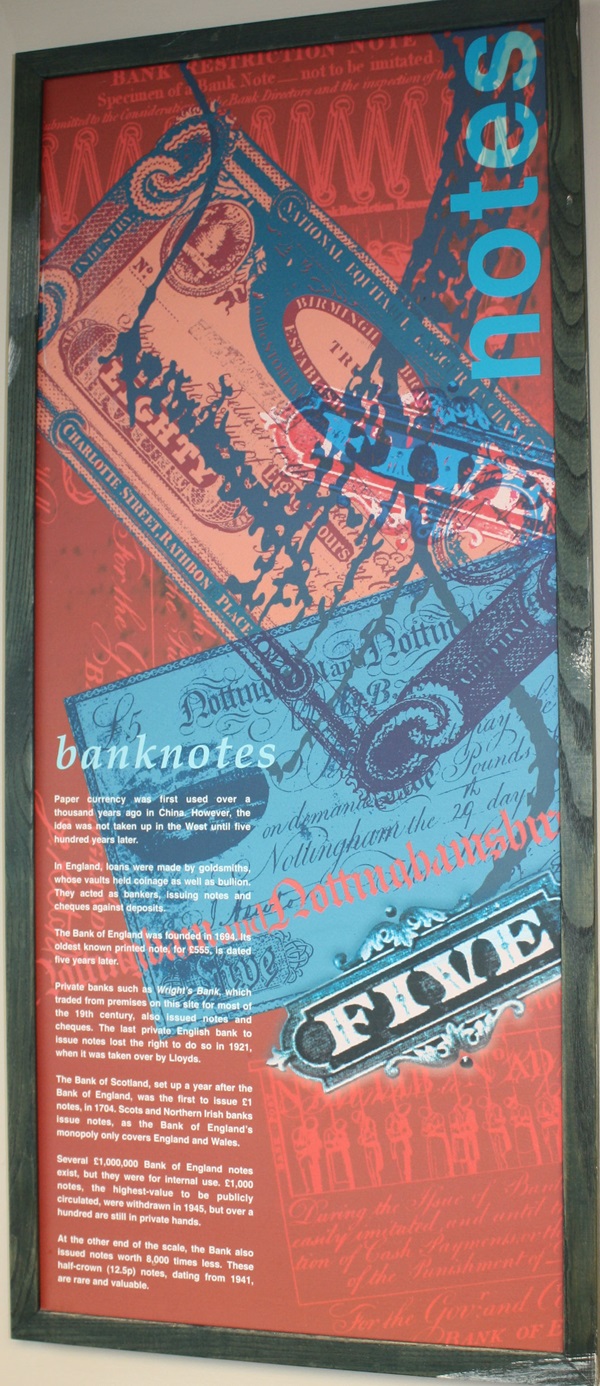
The text reads: Paper currency was first used over a thousand years ago in China. However, the idea was not taken up in the West until five hundred years later.
In England, loans were made by goldsmiths, whose vaults held coinage as well as bullion. They acted as bankers, issuing notes and cheques against deposits.
The Bank of England was founded in 1694. Its oldest known printed note for £555 is dated five years later.
Private banks such as Wrights Bank, which traded from premises on this site for most of the 19th century, also issued notes and cheques. The last private English bank to issue notes lost the right to do so In 1921, when it was taken over by Lloyds.
The Bank of Scotland, set up a year after the Bank of England, was the first to issue £1 notes, in 1704. Scots and Northern Irish banks issue notes, as the Bank of England's monopoly only covers England and Wales.
Several £1,000,000 Bank of England notes exist, but they were for internal use. £1,000 notes, the highest-value to be publicly circulated, were withdrawn in 1945, but over a hundred are still in private hands.
At the other end of the scale, the Bank also issued notes worth 8,000 times less. These half-crown (12.5p) notes, dating from 1941 are rare and valuable.
Illustrations and text about Swine Green.
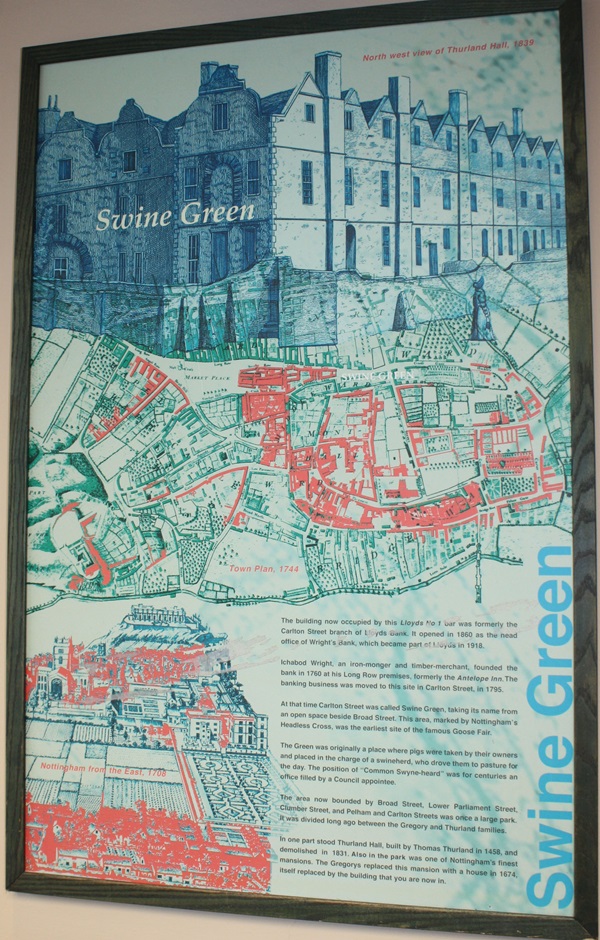
The text reads: The building now occupied by this Lloyds No 1 bar was formerly the Carlton Street branch of Lloyds Bank. It opened in 1860 as the head office of Wright's Bank, which became part of Lloyds in 1918.
Ichabod Wright, an iron-monger and timber-merchant, founded the bank in 1760 at his Long Row premises, formerly the Antelope Inn. The banking business was moved to this site in Carlton Street, in 1795
At that time Carlton Street was called Swine Green, taking its name from an open space beside Broad Street. This area, marked by Nottingham's Headless Cross, was the earliest site of the famous Goose Fair.
The Green was originally a place where pigs were taken by their owners and placed in the charge of a swineherd, who drove them to pasture for the day. The position of "Common Swyne-heard" was for centuries an office filled by a Council appointee.
The area now bounded by Broad Street, Lower Parliament Street, Clumber Street, and Pelham and Carlton Streets was once a large park. It was divided long ago between the Gregory and Thurland families.
In one part stood Thurland Hall, built by Thomas Thurland in 1458, and demolished in 1831. Also in the park was one of Nottingham's finest mansions. The Gregorys replaced this mansion with a house in 1674, itself replaced by the building that you are now in.
Prints and text about Lloyds Bank.
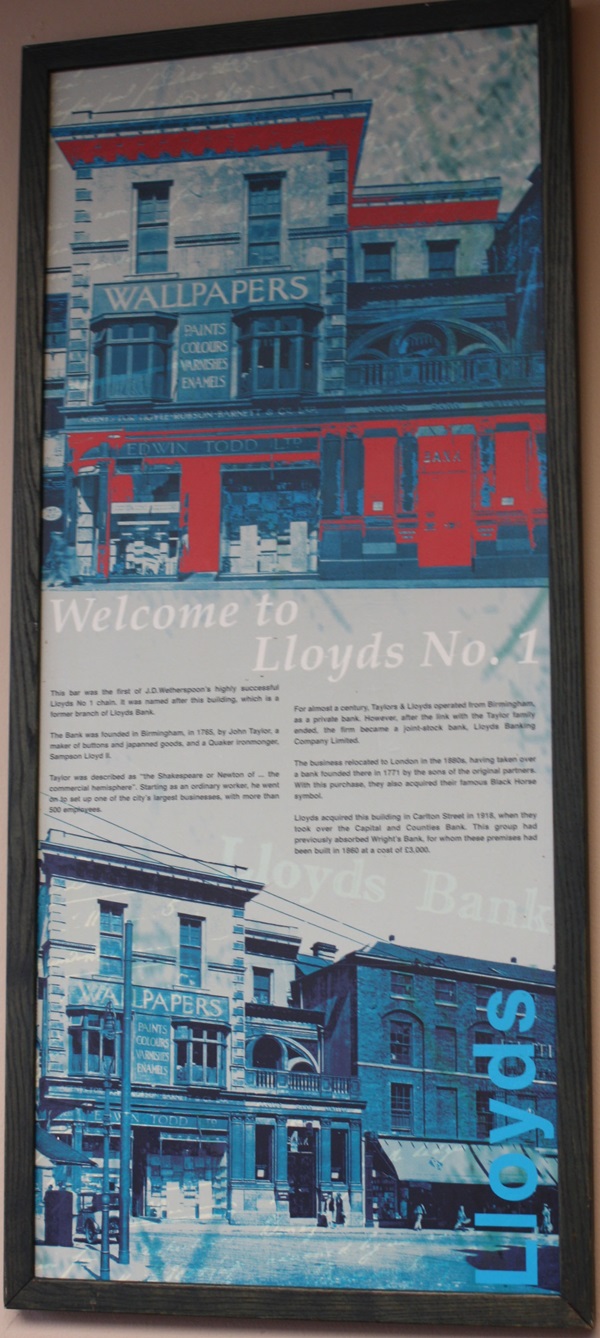
The text reads: This bar was the first of J.D Wetherspoon’s highly successful Lloyds No 1 chain. It was name after this building, which is a former branch of Lloyds Bank
The bank was founded in Birmingham, in 1765 by John Taylor, a maker of buttons and japanned goods and a Quaker ironmonger, Sampson Lloyd II.
Taylor was described as “the Shakespeare or Newton of... the commercial hemisphere”. Starting as an ordinary worker, he went on to set up one of the city’s largest businesses with more than 500 employees.
For almost a century, Taylor & Lloyds operated from Birmingham, as a private bank. However, after the link with the Taylor family ended, the firm became a joint-stock bank, Lloyds Banking Company Limited.
The business relocated to London in the 1880s, having taken over a bank founded there in 1771 by the sons of the original partners. With this purchase, they also acquitted their famous black horse symbol.
Lloyds acquired this building in Carlton Street in 1918, when they took over the Capital and Counties Bank. This group had previously absorbed Wrights Bank, for whom these premises had been built in 1860 at a cost of £3,000.
Photographs of Market Place.
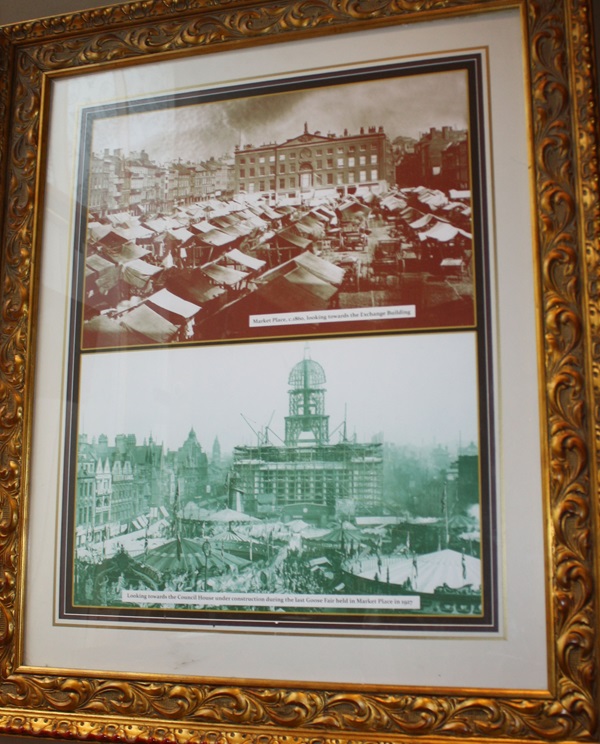
Illustrations and text about Market Square.
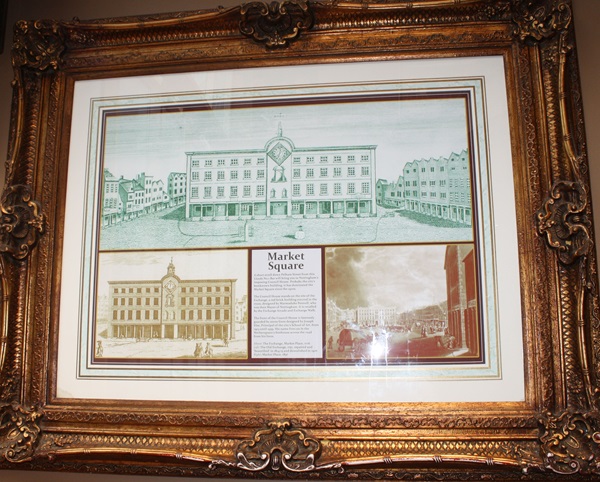
The text reads: A short stroll down Pelham Street from this
Lloyds No.1 Bar will bring you to Nottingham's imposing Council House. Probably the city's best known building, it has dominated the Market Square since the 1920s.
The Council House stands on the site of the Exchange, a red brick building erected in the 1720s, designed by Marmaduke Pennell, who was then Mayor of Nottingham. It is recalled by the Exchange Arcade and Exchange Walk.
The front of the Council House is famously guarded by stone lions designed by Joseph
Else, Principal of the city's School of Art, from 1923 until 1939. His name lives on in the
Wetherspoon's freehouse across the road from his lions.
Above The Exchange, Market Place, 1726
Left: The Old Exchange, 1751, repaired and ‘beautified’ in 1814-15 and demolished in 1926
Right: Market Place, 1837.
A photograph of the installation of Lord Trent (centre) as Chancellor of the University of Nottingham, 3rd May, 1949. John Campbell Boot, 2nd Baron Trent, was the son of Jesse Boot. He turned the Boots Company, founded by his father, into a major national company.
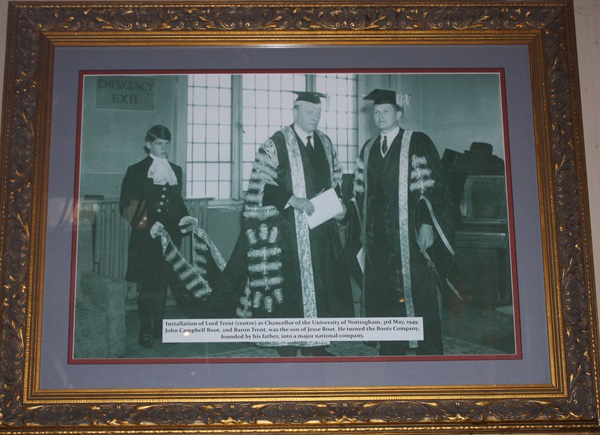
External photograph of the building – main entrance.
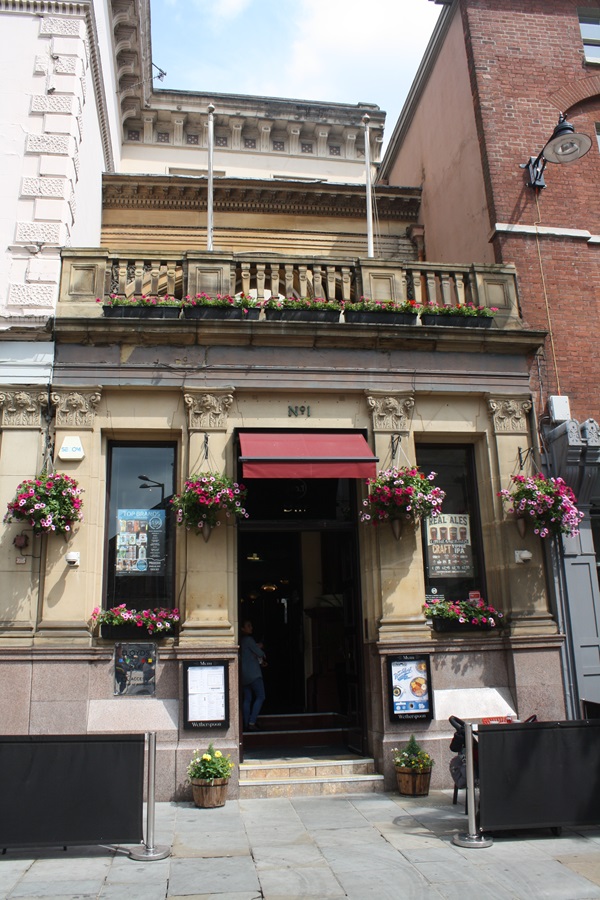
JD Wetherspoon PLC would like to thank ‘Picture the Past' for their generous assistance in compiling the display of local history in this Wetherspoon Lloyds No 1 free house.
‘Picture the Past' is a not-for-profit project, started in 2002, that aims to make historic images available from the library and museum collections across Nottinghamshire and Derbyshire.
By mid-2010 over 80,000 photographs. postcards, engravings and paintings had been added to the website.
Images courtesy of the following:
Nottingham City Council
L Cripwell
Samuel Bourne
K. Brand
Bernard Beilby
J. Orton
If you have information on the history of this pub, then we’d like you to share it with us. Please e-mail all information to: pubhistories@jdwetherspoon.co.uk